Cameras aboard JAMSTEC's Hyper-Dolphin ROV have captured footage of something strange lurking on the floor of Sagami Bay, southwest of Tokyo.
+ Video
Giant sea frog? Ningen? Smiling rock with sea sponge eyes? You be the judge.
Cameras aboard JAMSTEC's Hyper-Dolphin ROV have captured footage of something strange lurking on the floor of Sagami Bay, southwest of Tokyo.
+ Video
Giant sea frog? Ningen? Smiling rock with sea sponge eyes? You be the judge.
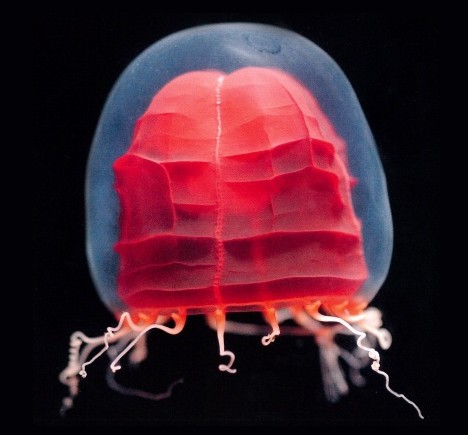
Red paper lanterns, or aka-chochin, are a familiar sight on the city streets of Japan, where they typically hang at the entrances to cheap pubs, capturing the attention of passersby. The ocean, however, is home to a different variety of red paper lantern -- an unusual species of deep-sea jellyfish.
Officially named Pandea rubra, the red paper lantern medusa (aka-chochin kurage) was first discovered in the Bering Sea in 1913, but details about its distribution and life cycle have long remained a mystery. In recent years, the creature has caught the eye of researchers at the Japan Agency for Marine-Earth Science and Technology (JAMSTEC) armed with high-definition video cameras.
Using manned and unmanned submersibles, the researchers have collected over 100 hours of high-definition footage showing more than 60 specimens of the jellyfish in waters from northeastern Honshu to Okinawa, at depths ranging from 500 to 1,000 meters. Here is some raw video:
The red paper lantern medusa has a transparent, bell-shaped hood measuring about 10 centimeters in diameter and 17 centimeters from top to bottom, with between 14 and 30 tentacles that extend up to 6 times the length of its body. Inside the transparent hood is a deep red colored mantle that can crumple up or expand like a paper lantern, hence the name. JAMSTEC researcher Dr. Dhugal Lindsay is credited with coming up with the name.
The gelatinous creature is commonly found at depths of between 450 to 900 meters in warm and temperate waters around the world. Observations have been reported in the Antarctic Ocean, but never in the Arctic Ocean.
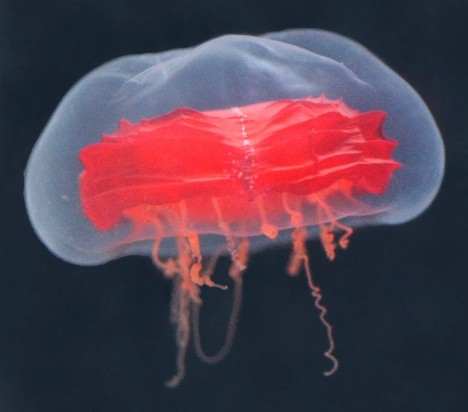
The JAMSTEC videos suggest that a variety of sea creatures regard the red paper lantern medusa as a safe place to establish temporary residence. In the video, the developing larvae of shrimp and sea spiders can be seen hitching extended rides on the jellyfish.
"We didn't expect to find such a variety of organisms attached to the jellyfish," said Dr. Dhugal Lindsay. "Humans apparently are not the only ones attracted to red paper lanterns."
[Source: Mainichi]
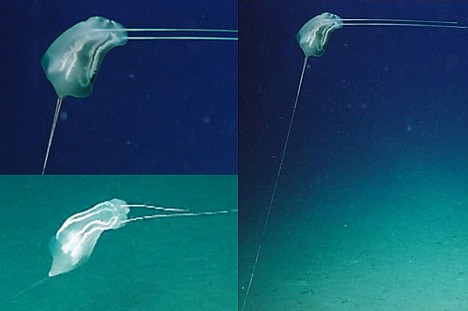
On June 11, the Japan Agency for Marine-Earth Science and Technology (JAMSTEC) released photographs of a mysterious deep-sea creature believed to be an unknown species of comb jelly, or ctenophore, a jellyfish-like marine animal. Taken by JAMSTEC's "Kaikou" unmanned submersible at a depth of 7,217 meters (nearly 24,000 feet) in the Ryukyu Trench about 200 kilometers (125 miles) south of Okinawa, the photographs show a gelatinous animal with two pairs of long, spindly tentacles -- one pair extended horizontally in front of its body and one pair stuck to the ocean floor, allowing the creature to float in place like a kite.
The creature's elongated body is 10 to 20 centimeters (4 to 8 inches) long and 5 to 8 centimeters (2 to 3 inches) wide. The rear tentacles measure 1.5 to 2.5 meters (5 to 8 feet) in length, while the forward-reaching tentacles, which float on the current and catch prey, measure between 1 and 1.5 meters (3 to 5 feet) in length. The animal's gastrovascular system, which circulates nutrients through the body, appears whitish in color.
JAMSTEC filmed the gelatinous animal in April 2002, and subsequent research has led the researchers to conclude it is very likely a new species. However, they are unable to say for certain until they capture an actual specimen.
[Source: Asahi, JAMSTEC press release, photos]
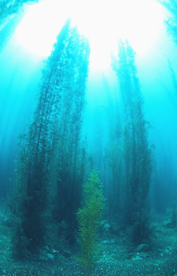 On March 22, a group of Japanese scientists released details of an ambitious proposal calling for the large-scale production of bioethanol made from cultivated seaweed.
On March 22, a group of Japanese scientists released details of an ambitious proposal calling for the large-scale production of bioethanol made from cultivated seaweed.
Researchers from Tokyo University of Marine Science and Technology, Mitsubishi Research Institute, Mitsubishi Heavy Industries and several other private-sector firms envision a 10,000 square kilometer (3,860 square mile) seaweed farm at Yamatotai, a shallow fishing area in the middle of the Sea of Japan. They claim a farm of this scale could produce about 20 million kiloliters (5.3 billion gallons) of bioethanol per year, which is equivalent to one-third the 60 million kiloliters (16 billion gallons) of gasoline that Japan consumes each year.
Seaweed has long been discussed as a potential source of bioethanol, which is typically made from crops such as sugar cane and corn, but the idea has never been brought to fruition. According to the proposal, giant nets used in nori and wakame seaweed cultivation would be laid out to cultivate sargasso seaweed (hondawara), which grows rapidly. Floating bioreactors -- special facilities that use enzymes to break the seaweed down into sugars -- would prepare the seaweed for conversion into ethanol, which would also be done at sea. Tankers would then transport the ethanol to land.
The main components of seaweed are fucoidan and alginic acid. While an enzyme for breaking down fucoidan has already been discovered, the scientists are looking for an enzyme that breaks down alginic acid. They are also looking at the possibility of using genetic modification technology.
The group is also conducting research on how to develop the production plants and attract investment. Other participants in the project include NEC Toshiba Space Systems, Mitsubishi Electric, IHI, Sumitomo Electric Industries, Shimizu Corporation, Toa Corporation, Kanto Natural Gas Development Co., Ltd., and the Japan Agency for Marine-Earth Science and Technology (JAMSTEC).
The researchers claim that in addition to serving as a source of fuel, the seaweed would help clean up the Sea of Japan. According to Professor Masahiro Notoya from Tokyo University of Marine Science and Technology, the seaweed would work to remove some of the excess nutrient salts that flow into the sea from the surrounding land masses.
Professor Notoya will formally present the proposal at the International Seaweed Symposium, which is set to begin on March 26 in Kobe, Japan.
[Source: Fuji Sankei]
UPDATE Dec 21, 2006: Winners announced
GRAND PRIZE: Robotic building cleaning system (Fuji Heavy Industries and Sumitomo). The system received high marks for its efficiency and its ability to work both independently and alongside humans. The judges believe the robot has great potential to develop the market for robotic cleaning systems, as well as establish new business models in which robots and humans work side by side to provide inexpensive cleaning services.
SMALL-TO MEDIUM-SIZED VENTURE PRIZE: KHR-2HV (Kondo). The judges gave high marks to KHR-2HV for its relatively low price tag and its popularity with individual users both young and old. KHR-2HV was also recognized for fostering closer ties between humans and robots, as well as for its educational value.
HONORABLE MENTION: My Spoon (SECOM). The judges awarded their special prize to My Spoon for its contributions to society. The robot has received praise both in Japan and overseas for helping people enjoy the meals they want to eat and enabling them to eat with friends and family. The judges recognized the high quality of My Spoon resulting from SECOM's close cooperation with users and medical professionals in the development phase. They also like it because it is affordable.
// Dec 21, 2006 //
====================
Japan's Ministry of Economy, Trade and Industry (METI) has announced its top ten list of finalists for the 2006 Robot Award. The ten robots selected from 152 applications fall into four categories -- service robots, industrial robots, public sector robots, and small- to medium-sized venture robots.
METI established the annual Robot Award this year to recognize outstanding developments in the field of robotics, encourage further research and development, and stimulate demand. Winners of the grand prize and the special prize for small- to medium-sized ventures will be announced on December 21.
Here's a rundown of the top robots in each category...
SERVICE ROBOTS:
 - Paro -- seal robot with therapeutic properties (Intelligent System/ AIST/ Microgenics)
- Paro -- seal robot with therapeutic properties (Intelligent System/ AIST/ Microgenics)
Paro is a furry white robot modeled after a baby harp seal. Paro can serve as a pet alternative for general households, and research has shown that Paro has therapeutic effects on patients. Paro's entire body is covered in tactile sensors, and its actuators provide it with smooth movement. Lovingly crafted one by one, Paro is recognized for its safety, cleanliness, user-friendliness and durability. About 800 of the robotic seals have been adopted around Japan, and Paro's future plans include overseas travel. [More]
* * * * *
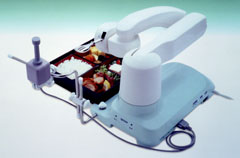 - My Spoon -- meal assistance robot (SECOM)
- My Spoon -- meal assistance robot (SECOM)
Designed to assist patients unable to use their hands, My Spoon enables users to enjoy ordinary meals by transporting food from a tray to the patient's mouth, one bite at a time. Users can select from three levels of contol -- manual (joystick control), semi-automatic or fully automatic -- to best suit their physical condition. My Spoon is available outside Japan, in the Netherlands and other locations in Europe. [More]
* * * * *
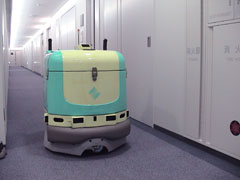 - Robotic building cleaning system (Fuji Heavy Industries/ Sumitomo)
- Robotic building cleaning system (Fuji Heavy Industries/ Sumitomo)
This autonomous robot roams the hallways of buildings, performing cleaning operations along the way. Capable of controlling elevators, the robot can move from floor to floor unsupervised, and it returns to its start location once it has finished cleaning. The robot is currently employed as a janitor at 10 high-rise buildings in Japan, including Harumi Triton Square and Roppongi Hills. [More]
* * * * *
INDUSTRIAL ROBOTS:
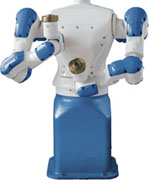 - MOTOMAN-DIA10/ MOTOMAN-IA20 (Yaskawa Electric)
- MOTOMAN-DIA10/ MOTOMAN-IA20 (Yaskawa Electric)
These industrial robot arms are capable of human-like movement, which is great news for factories worried about Japan's shrinking population (and human labor force). The DIA10 consists of two 7-axis arms mounted on a torso.
According to this spec sheet (PDF), the robot has the "finesse of the human arm without the physical limitations." The same 7-axis design is incorporated into the IA20, a "snake" robot with great freedom of movement and the ability to operate in tight spaces.
* * * * *
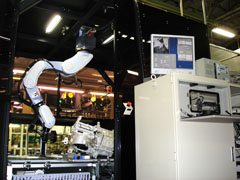 - High-speed reliability verification robot (Denso Wave)
- High-speed reliability verification robot (Denso Wave)
This robot relies on advanced machine vision technology to perform automated inspections on the go.
Highly reliable inspections can be performed at each location without stopping the line, allowing for speedier and more cost-effective operations.
[More]
* * * * *
PUBLIC SECTOR ROBOTS:
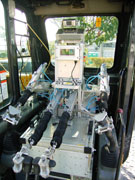 - Tele-operated construction equipment (Fujita/ Technical Office of Kyushu, Ministry of Land, Infrastructure and Transport (Kyugi))
- Tele-operated construction equipment (Fujita/ Technical Office of Kyushu, Ministry of Land, Infrastructure and Transport (Kyugi))
These remote-control unmanned construction machines were originally developed for dangerous recovery operations following disasters such as avalanches and rockslides.
Designed to prevent the occurrence of secondary disasters and greatly limit further damage and injury, these robots were deployed at the site of a disastrous mudslide that occurred in Okinawa in June 2006. [More]
* * * * *
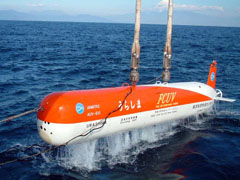 - Urashima -- deep-sea autonomous underwater vehicle (Japan Agency for Marine-Earth Science and Technology)
- Urashima -- deep-sea autonomous underwater vehicle (Japan Agency for Marine-Earth Science and Technology)
Urashima is a remotely operated vehicle for deep-sea exploration. The 10-meter long vessel relies on hydrogen-based fuel cell batteries that allow it to travel much greater distances than vessels powered by standard lithium-ion batteries. Urashima is expected to play an important role in pre-dive surveys for manned submarines and in the survey of areas considered dangerous for or inaccessible by manned research submarines. [More]
* * * * *
SMALL-TO MEDIUM-SIZED VENTURE ROBOTS:
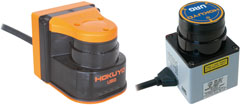
These lightweight, compact laser range finders feature low power consumption, making them ideal sensors for autonomous mobile robots. [More]
* * * * *
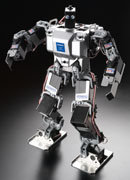 -KHR-2HV (Kondo)
-KHR-2HV (Kondo)
KHR-2HV is a high-performance build-it-yourself biped humanoid robot kit.
The popular KHR-2HV is faster, lighter and more agile than its predecessor, KHR-1, and it is packed with more controls, gears, servos and software.
Seventeen adjustable joints allow KHR-2HV to perform back flips, cartwheels and human-like moves, and USB connectivity means you can teach it lots of neat tricks. [More]
* * * * *
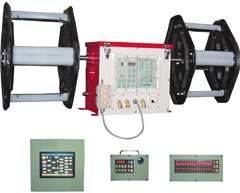 - Squid-fishing machine (Towa Denki)
- Squid-fishing machine (Towa Denki)
Towa Denki has made a number of improvements to its automated squid-fishing machines since the company began manufacturing them in the 1970s.
Relying on functions such as high-tech load detectors, squid finders and water depth detectors, the machines can perform automated operations that boost squid-fishing productivity. [More]
[Source: Robot Award 2006]
 Outcrops of combustible ice, or methane hydrate (also known as methane ice or methane clathrate), which many view as a potential source of fuel in the future, have been discovered on the ocean floor near the coastal city of Joetsu in Niigata prefecture. According to a statement made by scientists on February 20, the methane hydrate appears to be the exposed tips of ice columns that extend about 100 meters (325 feet) beneath the ocean floor.
Outcrops of combustible ice, or methane hydrate (also known as methane ice or methane clathrate), which many view as a potential source of fuel in the future, have been discovered on the ocean floor near the coastal city of Joetsu in Niigata prefecture. According to a statement made by scientists on February 20, the methane hydrate appears to be the exposed tips of ice columns that extend about 100 meters (325 feet) beneath the ocean floor.
The recent discovery marks the first time that exposed methane hydrate deposits have been found in Japanese waters. Methane hydrate, which is normally found several hundred meters beneath the ocean floor, is a sherbert-like substance that burns when exposed to flame. It forms when low temperature and high pressure under the ocean floor causes methane molecules to become trapped inside frozen water molecules.
Scientists from the University of Tokyo, the Japan Agency for Marine-Earth Science and Technology (JAMSTEC), and the National Institute of Advanced Industrial Science and Technology (AIST) are working together to collect samples from two points located at depths of 800 to 1000 meters (2600 to 3300 feet), about 30 kilometers (19 miles) offshore. They are using unmanned submarines to collect the ice. Based on the high electrical conductivity of the ground beneath the ocean floor, the scientists suspect the existence of large underground columns of methane hydrate.
While methane hydrate is being hailed as a potential source of fuel in the future, methane is a greenhouse gas. Methane is generated when organic matter in deep layers of sedimentary rock breaks down due to heating. The methane moves into upper layers, where it accumulates and forms methane hydrate. As the temperature rises and pressure falls, methane hydrate dissociates into methane and water. The resulting methane concentration in the surrounding seawater ranges from dozens to thousands of times higher than normal.
The research group is also committed to exploring the impact that the use of methane hydrate will have on global warming.
[Source: Asahi Shimbun]